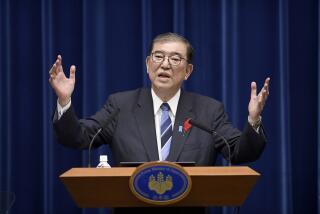Japan Coalition Pulls Back From Brink of Collapse : Politics: Conservative leaders boycott talks to pick a successor to Hosokawa. But they agree to try again.
- Share via
TOKYO — Japan’s ruling coalition inched back from the brink of collapse today as both of its warring camps indicated they will try again to select a candidate for prime minister from within their ranks.
But hostilities remained high between the forces led by Japan Renewal Party official Ichiro Ozawa and those of New Party Harbinger leader Masayoshi Takemura. In the clearest sign yet of a break between the two camps, conservative coalition leaders had boycotted a meeting Monday and another today with their more liberal partners on selecting a successor to Prime Minister Morihiro Hosokawa.
Hosokawa stunned Japan’s political world last week by abruptly announcing his resignation amid mounting questions over questionable stock deals, loans and his personal finances.
The lines between the two camps were sharply drawn when Takemura called a meeting of party heads to discuss Hosokawa’s successor and three of the coalition members--the Renewal Party, the Buddhist-backed Clean Government Party and Hosokawa’s Japan New Party--refused to attend.
The three groups said the appropriate forum to discuss the issue is a meeting not of party heads but of secretaries general, which would include Ozawa. They said they suspected that Takemura called the meeting of party heads deliberately to exclude his rival Ozawa.
Some of the Japanese media pronounced the boycott the de facto end of the coalition, an eclectic group spanning the political spectrum. Last July, its members cobbled together a ruling majority to end 38 years of iron rule by the Liberal Democratic Party.
Although the liberal side had warned that the coalition would shatter if the conservatives boycotted the meeting again today, Takemura, in a change of tactics, called on the two sides to make a fresh start. Yuichi Ichikawa, leader of the Clean Government Party, immediately accepted the olive branch and vowed to try to repair the split.
As chaos mounted and the power vacuum deepened, operatives in each party maneuvered to try to fashion a majority, meeting secretly with former political enemies and reaching across party lines. A majority of the lower house of Parliament is necessary to elect a prime minister in the case of two candidates; a runoff is held between the top two vote-getters in the case of more than two.
Although many observers had initially focused on Foreign Minister Tsutomu Hata as Hosokawa’s successor, former Foreign Minister Michio Watanabe assumed center stage Monday. He gave his strongest indication yet that he and his followers are ready to bolt the Liberal Democratic Party and join the Ozawa side in exchange for the prime minister’s post. Asked Monday about his will to do so, Watanabe declared, “I have the will, the spirit and the physical strength.”
Watanabe began collecting signatures from party members to support his candidacy. But it looked increasingly unlikely today that Watanabe, a blunt and witty politician whose political gaffes are legendary (he once said black Americans blithely declare bankruptcy to skip out on debts), could persuade enough followers to leave the party.
As a result, some members of the Clean Government Party and the Renewal Party were reported having second thoughts about splitting the coalition.
In another development, LDP President Yohei Kono--a relatively young and fresh-faced politician elevated for his reformist image--announced today that he will run for prime minister.
Should Watanabe decide not to bolt the LDP, another scenario being discussed is an alliance of longtime political opponents--the Socialists and the LDP, along with the New Party Harbinger.
Although such a scenario may seem improbable on its face, there are few real policy differences between conservative Socialists and liberal LDP members, said political commentator Yoshimi Ishikawa. He noted that in recent months, the Socialists have changed policies on opening Japan’s rice market, accepted the necessity of nuclear power and recognized South Korea rather than only its Communist neighbor to the north.
But the single largest factor driving the different alliances, he said, is Ichiro Ozawa. “Eight months ago, it was LDP versus anti-LDP,” he said. “From today, it is Ozawa versus anti-Ozawa.”
Indeed, Takemura’s New Party Harbinger issued a new policy platform Monday that further sharpens its differences with Ozawa and calls for reshaping the political landscape from scratch. In the most conspicuous slap at Ozawa’s ideas, the platform calls for respecting Japan’s war-renouncing constitution and rejecting a role for Japan as a major political or military power. It urges a more democratic, open policy-making process--an indirect criticism of Ozawa’s penchant for wielding power behind the scenes.
But New Party Harbinger official Yukio Hatoyama said the platform is not necessarily an anti-Ozawa treatise.
More to Read
Sign up for Essential California
The most important California stories and recommendations in your inbox every morning.
You may occasionally receive promotional content from the Los Angeles Times.














